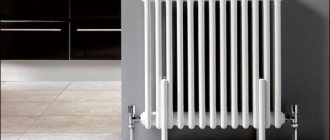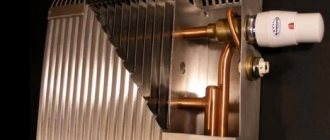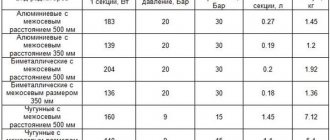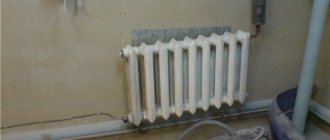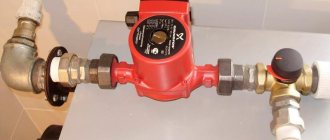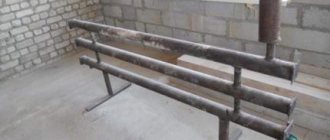Thermostat and thermostat, temperature controller and heat regulator are the names of the same device, the task of which is to maintain a constant temperature set by the user. The thermostat for heating plays a key role, because it is it that ensures the possibility of autonomous operation of the heating system. Also, such devices are often used as part of ventilation systems, air conditioning, automobile engines, and so on.
Purpose of installation and operating principle
Properly selected and correctly adjusted thermostatic valves help save money on energy costs and maintain a comfortable room temperature. Modern boilers can be equipped with similar devices. But in this case it will change, heating all the rooms at the same time.
Unlike sensors on boilers, thermostats allow you to set the required level of radiator heating for each room. This mechanism is indispensable for centralized systems.
The thermostatic valve regulates the amount of coolant entering the battery depending on the ambient temperature. The mechanism works to lower temperatures, but is not capable of increasing them. The heating is limited automatically; it is enough to adjust the mechanism after installation.
What is a smart thermostat
First, let’s define what a smart thermostat is. It is a smart device equipped with humidity, temperature, motion and light detectors. Based on their readings, the device is able to successfully control heating, air conditioning, dehumidifier/humidifier, heat pump and ventilation. Self-learning thermostats have appeared relatively recently.
They are able to monitor the owner’s actions, highlight his preferences regarding the microclimate in the rooms and subsequently maintain the required parameters without human intervention. As we can see, a smart thermostat is complex and expensive equipment. The main factor for the success of its installation is the presence of an appropriate number of actuators installed in the apartment.
The more complex the engineering systems, the higher the feasibility of installing a smart thermostat. Otherwise, it will not meet the owner’s hopes and costs. And one more nuance. Most thermostats are designed to work in autonomous systems, that is, “directly” with heating devices of various types.
Such a device is not suitable for an apartment; there is simply nothing to connect it to. In this case, you need to look for devices adapted to work with a centralized heating system. There are not many of them, but they exist.
Device
The operating principle of a thermostatic valve may differ depending on the type of device.
But the design of any model is based on a thermal valve and a thermostatic head. A valve is a valve consisting of a seat and a shut-off cone. This part opens or closes the flow of coolant after reaching the user-set temperature in the room. The operation of the thermal valve is controlled by a thermostatic head, that is, a temperature sensor.
Any thermostat is equipped with an arrow that indicates the direction of coolant flow. When installing the device, its direction must coincide with the coolant circulation pattern in the system.
Design of thermostats for heating radiators
The thermostat for a heating radiator consists of two parts - a valve (thermal valve) and a thermostatic head (thermostatic element, temperature regulator). These products are manufactured for different pipe sizes and different types of heating systems. The thermostatic regulator is removable; regulators of different types and even from different manufacturers can be installed on the same valve - the seat is standardized.
The thermostat for a heating radiator consists of two parts - a special valve and a thermostatic regulator
Valves and regulators are all different; before installing a thermostat for a heating radiator, you need to familiarize yourself with its structure, functions and types.
Kinds
Thermostats on the market differ in the way they are controlled.
Mechanical
Provide manual adjustment of coolant flow. These are inexpensive models, easy to set up and do not cause malfunctions. Mechanical thermostats consist of a gas or liquid bellows, an actuator and a regulator. The valves of such mechanisms have a scale indicating the degree of heating of the radiator.
The installation is carried out experimentally, by gradually turning the valve. When the valve is turned, the coolant enters the spool and affects the position of the rod, which, under the influence of pressure, blocks the coolant flow.
The disadvantage of such devices is the need for regular adjustments, depending on the ambient temperature.
Electronic (automatic)
Microprocessors are installed inside such thermostats, which are responsible for regulating the heating of the radiator. The mechanisms are equipped with sensors that allow them to measure the ambient temperature and, in accordance with it, regulate the supply of coolant to the radiators without human intervention. Automatic models are configured using the keypad.
The mechanical part of such a thermostat is no different from manual models. The bellows in them are cylindrical, and the walls are made in the form of corrugation. Inside the bellows there is a substance that reacts to the ambient temperature. When heated, it expands, and the pressure inside the device increases, affecting the position of the rod. It regulates the volume of coolant entering the radiator. When the temperature decreases, the reverse process occurs.
Expert opinion
Torsunov Pavel Maksimovich
Such a thermostat is very reliable, the bellows can withstand tens of thousands of compressions and expansions, its resource will last for more than 10 years.
Among electronic thermostats, two types of devices can be distinguished:
- Closed . They cannot determine the temperature automatically, so the user must make the settings independently. Its advantage over a manual device is only that you can set the temperature in degrees, and not like on a graduated scale of more or less.
- Open ones are complex electronic devices with programming capabilities. When the temperature rises or falls to a certain threshold, the device automatically changes its operating mode to the one set by the user.
Electronic thermostats operate from replaceable batteries – batteries. It does not consume much energy, so frequent replacement is not required: no more than 2 times during the entire heating season. There are models that have a battery with a charger.
Buy a room thermostat for heating.
We recommend that you buy a thermostat for heating or buy a thermostat for a gas boiler in order to establish home automation as part of controlling the heating system. This will provide comfort, ensure safe operation of the heaters, and reduce energy costs for the operation of heating devices. Installing a regulator will definitely pay off. The best choice is reliable electronic thermostats. There is a wide range of such devices on sale. The price of a heating temperature controller varies. Our online store Teploregulyator.ru has a large selection of climate control devices from various global manufacturers. We deliver products throughout Russia and neighboring countries.
Buying a pump activation regulator is very simple! Call us for advice on choosing products, as well as assistance in placing an order.
Criterias of choice
When selecting a thermostat model, most users focus on price. Mechanical models are several times cheaper than electronic ones, but at the same time less convenient to operate. The most convenient are electronic devices with programming capabilities.
With their help, you can set the temperature for different time periods. Such thermostats are able to turn off the heating for the period when no one is in the apartment, and bring the temperature to comfortable values at the required time. You can also program day and night modes for heating the room.
Thermostats also differ in internal content:
- Devices with bellows filled with liquid are inexpensive, but their response to temperature changes in the environment is somewhat slower.
- Gas-filled thermal heads are very sensitive to any temperature fluctuations. They will “notice” if the air in the room becomes warmer because the sun is shining through the window and will close the valve, stopping the supply of media.
This criterion is important to consider when purchasing a specific model.
It is also important to take into account the following differences between gas and liquid thermostats:
- Gas-powered devices have a long service life. At the same time, the gas reacts smoothly to temperature changes, which does not cause excessive sudden loads on the device. Liquid ones operate quickly, which has a greater impact on the wear of working parts, but allows you to quickly respond to a drop or rise in temperature.
- In liquid thermostats, the sensor can be remote or built-in. If it is built-in, then the device is placed in a horizontal position to reduce the influence of convection currents from the radiator and pipes.
- It is advisable to install remote-type sensors when the device is covered with thick curtains that affect heat transfer, the thermostat is located vertically, the radiator is installed in a deep wall niche or too close to the window sill.
Let's look at the numbers.
The price of metering devices depends on their type and starts from 7,000 rubles. To this you need to add the cost of obtaining permits and services for installing the device. In addition, you need to remember that the meter is subject to periodic verification and replacement, like any other metering device. The price of a smart thermostat starts from 5,000 rubles without installation.
To this we must add the price of programmable thermostats installed on radiators. This is at least another 3,000 rubles. for each device. Thus, we receive a fairly impressive amount that will be required to implement intelligent heating control in the apartment. The expected savings, according to specialists' calculations, will be about 30% of the existing payment amount.
At the same time, you need to understand that savings will depend not only on the operation of the thermostat, but also on how well the apartment is insulated and whether there are sources of heat leakage. Another important factor. A smart thermostat is designed to control several systems; their presence in the average apartment is highly doubtful. Thus, it is unlikely that it will be possible to use all the capabilities of smart equipment.
As a result, it turns out that the costs of purchasing and installing equipment will be quite large, especially if you choose modern devices from a trustworthy manufacturer. However, it will not be possible to use their full potential. Still, UDs are intended, rather, for houses with autonomous life support systems.
The savings compared to the costs are not that big. Is such a solution viable? It is up to those who want to implement it in their apartment to decide.
Best models
Manufacturers offer customers various models of mechanical and automatic thermostats for radiators. The following devices received the greatest number of positive reviews.
Valtec corner 1⁄2
The Valtec brand has been trusted by plumbing experts for several decades. This thermostat model is an angle valve for installation in a system with a maximum temperature of up to 110 degrees and a pressure of no more than 10 bar.
Advantages of the model:
- compactness and ease of installation;
- durability (up to 30 years) and maintainability;
- combination of quality and low price.
The disadvantages of the model include:
- risk of flooding of the apartment if the pressure in the pipes rises to more than 10 bar.
Danfoss RA 2994
Model with gas filler, combined with the RA-G valve, which allows servicing single-pipe heating systems. The thermostat of this brand is designed for diameters from 15 to 25 mm. Danish-made equipment has been familiar to domestic specialists since the 70s of the last century. The devices are compatible with any heating boilers.
The clip connection of this model allows for simple and precise attachment of the thermocouple to the valve. Technical characteristics of RA type radiator thermostats comply with European standards EN 215–1 and Russian GOST 30815–2002.
Advantages of the model:
- easy installation and setup;
- possibility of precise temperature control;
- acceptable cost.
Many users consider the disadvantage:
- low maximum temperature threshold - only up to 26 degrees.
Techem HKR
Universal automatic mechanism with a large informative display.
Powered by batteries, which ensures autonomous operation. Equipped with an effective safety system and protection against lime deposits, freezing and jamming of valves. It is possible to program several modes. Users note the ease of control of the mechanism and simplicity of settings. Separately, it is worth noting the ability to set a certain temperature for several days in advance. This model has practically no drawbacks, other than the instructions being too small.
FIBARO. The Heat Controller for Apple Homekit
A smart device running Apple HomeKit to control room temperature using Bluetooth wireless technology. An advanced control algorithm and scheduled operation allows you to save up to 42% on heating bills.
The FIBARO thermostat works with 98% of radiators available on the market. The built-in battery, charged via USB, is enough for the entire heating season. Operating temperature: 0-40 degrees.
Advantages of a thermostat:
adaptation to weather and indoor conditions;- compatibility with different heating sources;
- schedule adjustment with the ability to make temporary changes;
- temperature adjustment depending on the geolocation of users;
- raising the temperature to an optimal level when motion is detected in the room;
- turning off the heating when an open window is detected;
- use voice commands to adjust temperature;
- child lock;
- the presence of an automatic descaling mode;
- Temperature measurement accuracy is up to 0.5 degrees.
Sibling Powerswitch-ZK
Smart thermostat with remote control: according to a set schedule, according to sunrise/sunset, set temperature or air humidity outside. Maintains the set temperature by controlling a conventional damper rod of a home radiator. It is possible to add a device via a gateway to a security system and other elements of a Sibling brand smart home. Operating temperature range – from 0 to + 40 degrees.
Zigbee Ya-HY368
The smart temperature controller is battery-powered, is a wireless device and is used in conjunction with the Ya-ZB1 multifunctional ZigBee gateway “I am Smart” controlled by the “I am Smart” mobile application. Easy to install, mounted in the same way as a traditional manual radiator temperature controller.
The screen and buttons provide intuitive operation. Using the Ya Smart application allows you to remotely set schedules, view and set the temperature. Equipped with built-in clock and calendar
Advantages of the model:
- schedule for a week in advance, energy saving modes;
- four independent time periods for setting temperatures throughout the day
- mode selection by pressing one button;
- control of several thermostats installed in different places (for example, in a country house, administrative buildings or office center) from one mobile application;
- control via the Internet without a subscription fee.
- local (from the controller display) and remote (from a mobile application) mode of monitoring and setting the temperature of the rooms or heated floor;
- the ability to work without connecting to ZigBee and the Internet; in the absence of a Wi-Fi network or the Internet, the controller operates according to the specified parameters. The schedule is stored in the thermostat's memory;
- creating various scenarios together with other “I am Smart” devices;
- automatic calibration and regular self-testing prevent valve sticking and lime deposits;
- safety: frost protection, child protection, automatic protection against valve clogging through independent actions without human intervention.
- automatic switching of heating to economical mode in the house when leaving home (based on geolocation or the presence of a phone in the home Wi-Fi network);
- setting a schedule for setting different operating temperatures throughout the day and week.
The only drawback is the high price.
Installation Rules
Thermostats are installed at the inlet or outlet of the radiator. Installation is standard - on linen winding or FUM tape. The process itself is also standard. The thermostat has a thread for which the appropriate fittings are selected. Or taps are used to cut internal threads on a metal pipe.
When choosing an installation location, consider the following:
- Recommended height. This item is indicated in the technical documentation for the device. Each device is calibrated at the factory to control temperature at a certain altitude. As a rule, this is the upper radiator manifold, approximately 60-80 cm.
- If the radiators only have a bottom saddle connection, there are three options: look for a device that can be installed at the bottom, install a model with a remote sensor, or reconfigure the thermal head. The procedure is simple; the description must be in the passport. You will need to have a thermometer and at certain moments turn the head in one direction, then in the other direction.
What thermostat is on your radiator?MechanicalElectronic
- An important point that those who want to install a thermostat for a heating radiator in apartment buildings should remember. If you have a single-pipe installation, they can only be installed if there is a bypass - a section of pipe that stands in front of the battery and connects the two pipes to each other. If you have a similar wiring (there may not be a pipe on the right), a bypass is required. The thermostat should be installed immediately behind the radiator. Otherwise, you will regulate the entire riser, and the neighbors will not like this. For such a violation, a very substantial fine can be issued. Therefore, it is better to install a bypass.
- In two-story buildings, the recommended location of the thermostat is on the second floors. This is where the warm air is directed, and the first floor invariably turns out colder.
- Thermostats with sensors are installed in rooms where air movement is not obstructed. The indicator is placed strictly horizontally so that it shows a reliable picture. It should be taken into account during installation that the thermostat valves are equipped with an external thread on one end, and oriented inward on the other.
- It is not allowed to place automatic thermostats behind thick fabric drapery or behind a decorative screen. If you do this, the system will begin to measure the heating inside the cavity that appears, and not in the room itself. The solution to the problem is either the use of a remote sensor, or placing the regulator on horizontal sections of the system, as close as possible to the entrance to the radiator.
If the heating system is not created from scratch, before installing the thermostat, all water should be drained from it before installation work begins. When the heating season ends, the thermostat is opened to avoid the accumulation of sediment inside the mechanism.
Thermostatic heads
Thermostatic elements for heating thermostats come in three types - manual, mechanical and electronic. They perform the same functions, but differ in different levels of comfort and capabilities.
Manual
Manual thermostatic regulators work like a regular faucet - by turning the regulator in one direction or another, the flow of coolant is adjusted. The cheapest and most reliable, but not the most convenient devices. To change the heat transfer, you must manually turn the valve.
Manual thermal head - the simplest and most reliable option
These devices are inexpensive and can be installed at the inlet and outlet of a heating radiator instead of ball valves. Any of them can be adjusted.
Mechanical
A complex device that maintains the set temperature automatically. The basis of this type of thermostatic head is a bellows. This is a small elastic cylinder that is filled with antifreeze. Antifreeze has a high expansion coefficient - when heated, it greatly increases in volume.
Thermostat device for a heating radiator with a mechanical thermostatic head
The bellows supports the rod, which blocks the flow area of the valve. Until the antifreeze in the bellows heats up, the rod is raised. As the temperature rises, the cylinder increases in size (antifreeze expands), it puts pressure on the rod, which increasingly blocks the flow area. Less and less coolant passes through the radiator, and it gradually cools down. The antifreeze in the bellows also cools down, due to which the cylinder decreases in size, the rod rises, more coolant flows through, and it begins to warm up a little. Then the cycle repeats.
Gas or liquid
With such a device, the room temperature is maintained correctly, but in general the delta depends on how inert the antifreeze in the bellows is. It can be filled with some kind of gas instead of antifreeze. Gases react more quickly to temperature changes than antifreeze, but are technologically more difficult to produce.
Antifreeze or gas in the bellows - there is not much difference
Liquids change volumes a little more slowly, but are easier to produce. In general, the difference in the accuracy of temperature maintenance is about 0.5 °C, which is almost impossible to notice. As a result, most of the presented thermostats for heating radiators are equipped with thermal heads with liquid bellows.
With remote sensor
The mechanical thermostatic regulator should be installed towards the room. This way the temperature is measured more accurately. Due to its large size, this installation method is not always possible. You can also install a thermostat for a heating radiator with a remote sensor. The temperature sensor is connected to the regulator using a capillary tube. It is located at any point at which it is more convenient for you to measure the air temperature.
With remote sensor
All changes in heat transfer from the radiator will occur depending on the air temperature in the room. The only disadvantage of this solution is the high cost of such models. But the temperature is maintained more accurately.
Electronic
The electronic thermostat for a heating radiator is even larger in size. The thermostatic element is even larger. In addition to the electronic filling, it also contains two batteries.
Electronic thermostats on batteries are large in size
In this case, the movement of the rod in the valve is controlled by a microprocessor. These models have a fairly large set of additional functions. For example, the ability to set the room temperature by the hour. How can this be used? Doctors have long proven that it is better to sleep in a cool room. Therefore, at night you can program the temperature lower, and in the morning, when it’s time to wake up, you can set it higher. Comfortable.
The disadvantage of these models is their large size, the need to monitor battery discharge (enough for several years of operation) and high price.
How to set up the device
All thermostats have factory settings. But the specified values are standard and may not coincide with the desires and requirements of users. In automatic models, it is enough to set the temperature on the display. The situation is more complicated with mechanical thermostats. To adjust them you will need a thermometer.
To change settings, do the following:
- Close all windows, doors, turn off hoods. Set the thermostat head to the extreme left position - “open”.
- As soon as the room temperature begins to rise and reaches 5 - 6 degrees above the desired value, turn the knob to the right - “closed”.
- The radiator will begin to cool down. Once the temperature readings reach the desired values, slowly begin to turn the head to the left. When you hear the noise of the coolant, stop and remember the position of the valve. To achieve the desired temperature, you will need to install the head in this position.
There will be no universal position for the mechanical thermostat. During the heating season, it will need to be periodically reconfigured, depending on weather conditions.
FAQ
Are modern thermostats compatible with old cast iron radiators?
In principle, thermostats can be installed on any battery. But the effectiveness of working on cast iron radiators is questionable. Such batteries are massive, hold a large amount of coolant and are therefore inert. They will respond too slowly to automatic adjustment using thermal heads. On old-style radiators, it is preferable to install a valve on the supply and a balancing valve on the return.
Is it worth installing a thermostat if there is a ball valve on the radiator and you can use it to regulate the heating of the room?
The ball valve does not regulate temperature effectively because there are only two preset modes: open and closed. If you try an intermediate position, the coolant will quickly damage the working part and the faucet will fail.
If there are several radiators in the room, should a thermostat be installed on each one?
It is not advisable to install thermal heads on every heating device. Only those radiators whose total thermal power exceeds 50% of the generation in a particular room are subject to adjustment. When there are two radiators, set the thermostat to the one that is more powerful. If there is equality in this indicator, they focus on the device closest to the heat source.
Installing a thermostat on batteries is an easy way to ensure a comfortable room temperature and at the same time save on energy costs. By choosing an automatic model, you will completely ensure uninterrupted heating operation without daily monitoring.
It is technically impossible to equip most apartments in Russia with such a meter.
By law, they can only be installed in apartments with horizontal wiring, when one riser goes inside, from which all radiators are powered in a ring. It is on this that the counter is mounted. If several risers enter the apartment, and this is the most common option, you will have to install a meter on each of them, which is unreasonably expensive and prohibited.
But even if you can install a meter in an apartment, this does not mean that you can pay according to its readings. The law provides for several options for payment for heat. Based on its provisions, payment using an individual meter is accepted only if all apartments in the building are equipped with them. If one or more apartments do not have metering devices, the fee is charged according to the readings of the common building meter.


